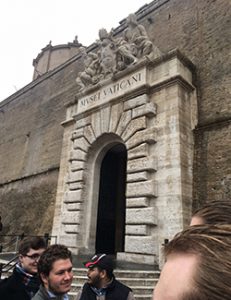
Jacob Chrisman ’20 — Today we explored the Vatican City where we started off looking at Early Christian art in the Musei Vaticani. The biggest take away was Christian expressionism pre-Constantine and post-Constantine. Pre-Constantine a lot of Old Testament images were used, however a transition to New Testament images and greater Christian expression was prevalent post-Constantine.
Another thing we did in the morning was explore the other parts of the museum. There were many imperial age busts; friezes, or inlaid wall sculptures; sarcophagi; and mosaics along with many renaissance art selections. To see these side by side was cool because of the influence of Roman art on the renaissance era.
We capped off the morning by looking at the Sistine Chapel and this has been by far the most amazing part of the trip for me. Ever since I saw pictures of Michelangelo’s paintings I’ve wanted to visit the Vatican. When I saw Michelangelo’s Creation of Adam I didn’t know how to feel. I was so over come with joy and emotion all I could do was stare at the scene for several moments. This feeling was unique to me, even in a city where wonders like this are around every corner.
In the afternoon we encountered was St. Peter’s Basilica that is built over the tomb of St. Peter. This was amazing despite the fact that I’m not particularly religious. To have “someone” that is one of the founders of Christianity, one of the 12 original apostles, right in front of you 2000 years later was amazing.
One thing that stood out to me was the Greek inscription that’s when translated says, “Peter is within.” Though this means almost nothing for the confirmation it acts as a grave marker or tombstone type deal that acts with the other elements that lead us to think that it is Peter. One of the early accounts of this is when Dionysus of Corinth writes to the Roman Church telling them about the burial place of Peter around 174 AD.
What’s most amazing to me is that about 138 years later Constantine builds a Basilica/Church with the alter over the tomb and then in the 16th century the Basilica/Cathedral is rebuilt but the high altar is in the same place. This is all done without confirmation of the tomb, but rather out of faith and belief that Peter is there. I think this speaks of the power of Christianity over people and this is evident in all the churches and religious symbols in the city.